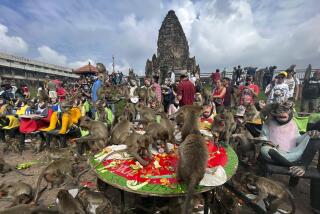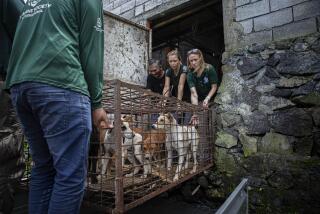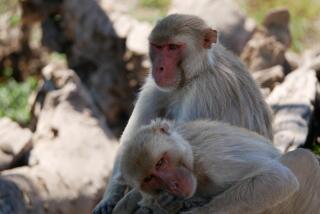Alarm among activists after Malaysia kills nearly 100,000 monkeys
Tourists adore them. Homeowners bemoan them. And the Malaysian government has killed them –- by the tens of thousands.
They are macaca fascicularis, mischievous monkeys with unusually long tails that give them their common name: long-tailed macaque. Malaysian wildlife officials killed more than 97,000 of them last year. Nearly 88,000 were culled the year before, according to the nation’s wildlife department.
Tourists and many Malaysians gather near jungle edges to watch the monkeys, snap photos of them and feed them peanuts and bananas. But the wildlife department, also known as Perhilitan, says the extensive culling was necessary to curb a “pest species” that breeds prolifically, adapts with ease, and ransacks homes for food.
“It is a hard decision, but in order to safeguard the well-being of people and to maintain a stable macaques population … it might be the best option in a short run,” the department said in an email to The Times.
It said it had tried chemical castration at five locations, but that approach worked best with small, localized macaque populations. The tactic also requires veterinarians, “and this department is in shortage of such specialized expertise,” it wrote. Relocating the monkeys didn’t work, it said.
Scientists and activists say Malaysian officials could have educated people to stop feeding the macaques and to better protect their food instead of killing so many animals.
The monkeys were killed because the government “thought it was easier than teaching people how to properly lock their houses and protect fruit trees,” said conservationist and primatologist Ardith Eudey, part of the Primate Specialist Group network.
Government figures shared by activists show macaques injured four people between January and September last year. Three years ago, a Malaysian newborn died after a macaque seized her and dropped her from a rooftop, according to the Star newspaper.
More common problems are much less grave: Macaques root through garbage bins and scatter trash, and they damage rooftops and lampposts, according to one recent study near Kuala Selangor Nature Park. Resident Salima Ibrahim said that if she cracked open a window on an especially hot day in Kuala Lumpur, monkeys would come in and grab bananas and feast on rice left in the cooker.
“They scared the life out of my mom and my children. They’d be running helter-skelter all over the house,” Ibrahim said, recalling the run-ins with macaques in the bungalow she once lived in. “They’d take clothes from the clothesline. You’d be driving down the lane and suddenly see -- ‘That shirt looks familiar. What’s it doing up that tree?’ ”
But for all the trouble they caused, “I don’t believe in culling them,” Ibrahim said. “The animals have a right to live in this climate.... You just have to live with it I guess.”
Killing such vast numbers of monkeys has also troubled some primatologists, who say the animals, long assumed to be safe, have not been rigorously counted and could be at risk if mass culling continues. Alternative strategies such as locking up trash could address the problems without killing, they say.
Animal rights activists shared photos of dead and bloodied monkeys, speckled with what appear to be gunshots.
“It is barbaric and inhumane,” Shenaaz Khan, president of the Malaysian Animal Welfare Society, said in an email. She alleged that monkeys were riddled with bullets after stumbling into traps and that in some cases, shooters vied for cash in competitions, getting roughly $82 for each macaque.
Wildlife officials denied there were culling competitions. Macaques are trapped and euthanized by injection, or shot if they cannot be trapped, Perhilitan said in an email.
Documents obtained by animal rights activists and shared with The Times show what appear to be Perhilitan’s goals for culling in each state – goals that the department appears to have exceeded. (Perhilitan denied there were quotas for killing macaques, saying culling was based on the seriousness of disturbances and other factors.) Government estimates put the number of Malaysian macaques at 740,000, based on surveys done before the culling in 2007, but researchers say estimates are so fuzzy as to be useless.
“There’s no good count,” said University of Notre Dame anthropology professor Agustin Fuentes. Numbers are often inflated because officials make their estimates by eyeing the landscape and calculating how many monkeys could live there, he said. But the macaques live at the edges of forests, and that’s exactly where they’re now in danger in Malaysia.
“There’s this huge false assumption that these monkeys are supposed to be in the middle of the rain forest somewhere,” said Michael Gumert, assistant professor at Nanyang Technological University in Singapore. That misconception poses “a very serious risk that if we remove all the macaques living by people, we actually remove a very large proportion of their population.”
Scientists worried about the macaques have struggled to convince others that a monkey so commonly seen around humans could be in jeopardy. Some conservationists don’t see the monkeys as truly wild. The Malaysia branch of the World Wildlife Fund turned down an interview request, saying that “metropolitan monkeys [do] not fall under the context of wildlife conservation.”
Wildlife officials say there is no risk of the monkey going extinct, because they exist throughout Southeast Asia. The International Union for Conservation of Nature categorized the species as being of “least concern” five years ago, the last time it was officially assessed.
However, “no one has factored in this massive culling” when assessing whether the monkeys are at risk, said Eudey, who is gathering information to help reassess their status. Wildlife trafficking from the region to China and the U.S. is another threat, she said.
Perhilitan said the killings did not violate its Wildlife Conservation Act, as alleged by some activists, because the law allows for macaques and other protected species to be killed to prevent damage to crops.
Fuentes and other scientists cited exploding urbanization in Malaysia as the root of the conflict. Perhilitan itself chalked up the increase in macaque problems to the “rapid increase of agriculture lands, new townships and urbanization in former wildlife habitats.”
“It all boils down to development,” Khan said. “The monkeys don’t have anywhere else to go.”
ALSO:
U.S. policy seen as factor in Somalia famine deaths
Russians monitored calls of Boston suspect’s mother, U.S. says
Desperate migrants meet with misery in Egypt’s Sinai Peninsula
More to Read
Sign up for Essential California
The most important California stories and recommendations in your inbox every morning.
You may occasionally receive promotional content from the Los Angeles Times.










